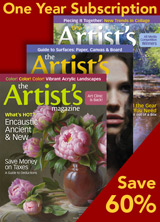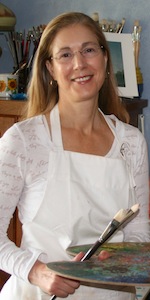My wise mother always reminds me, “scatter your fire, and you miss the mark.”
This rifle analogy, especially rings true for artists who need to take calm aim and focus in order to hit their mark.
Artists are multitalented individuals who sometimes lack this important discipline which is needed to obtain their desired goals. In fact, I know this from personal experience. I have so many interests, it is easy for me to find myself drifting away from the important tasks at hand. Lately, I am having to find a healthy balance between my painting, blogging and writing careers!
The guest article below has some great tips to help you keep your focus. ~Lori
 Focus and Plan to Paint!
Focus and Plan to Paint!
Guest author/artist: Marie Wise
People ask often ask me, “how do you manage to get so much done?” I don’t think I get much more done than the average person. But, after years of pursuing a full-time artist’s career while holding down a full-time job to pay the bills, I think I’ve honed an important skill every artist can use…
It’s called focus.
I call focus into play most of my waking hours. Whether I’m at my job, with a dozen projects on deadline, or in my studio at the end of the day, focus is the thing that helps me accomplish what I set out to accomplish.
For artists, focus is important because it defines what we want to do, how we do it, and whether we did it successfully.
I’ve broken focus into three key areas that every artist encounters while completing a work. In my case it’s a painting.
Focus #1: What do I want to paint and why do I want to paint it?
Focus #2: How am I going to paint it?
Focus #3: Did I successfully paint it and would I paint it again?
Let me explain:
- Focus #1: What do I want to paint and why do I want to paint it?
Paintings give birth in my mind long before touching the canvas. The process involves creative discrimination: why is the subject appealing, what is the color or symbolic message involved, what does it mean to me, what do I want the painting to say? I carry the gestation period with me wherever I go; while I’m at work, while I’m on my walk or in the shower, even when I’m sleeping.
The thinking process inevitably leads me to why I want to paint that subject. Then when I’m ready to paint, I know what I’m doing (and why)! I think this is especially important to artists who have to be away from their studios for other jobs. It clarifies the reason for putting forth all the effort that a painting inevitably requires.
- Focus #2: How am I going to paint it?
Since I already know what I want to paint and why, the ‘how am I going to paint it’ part has been solved. This is because subject often defines technique. But, I still need to break down a few areas:
Resources: depending on what I’m painting, I might need models, props, a still life set up or photography. Do I have everything I need?
Medium: what am I painting on: canvas, panel, paper? What size? Gessoing canvas or stretching watercolor paper entails dry time. The best use of my time is for drying to happen while I’m sketching and preparing compositions.
Technique: am I painting in a classical old masters style, or loose and Impressionistic. The subject often defines the technique. Figures often need underpainting layers (Verdaccio or Grisaille), but florals are often direct painting. Knowing how I’m going to apply the paint is best decided beforehand.
Sketch/Transfer/Paint: getting the composition onto the medium (canvas or paper) and starting to paint is always the best part. I feel like I’ve accomplished so much. Now it’s just a matter of giving my idea life through paint! I step back often and analyze how it looks, get a cup of tea and let the painting sink into my subconscious, after all, it’s been there for a long time! I take my time to feel good about what I’m doing, and enjoy the process.
- Focus #3: Did I successfully paint it and would I paint it again?
The painting is finally finished. I need to get some distance in order to objectively evaluate it. I’ll step away for a while then look at it again, which always gives me a fresh outlook.

Questions to ask include:
- Was I successful in what I originally set out to do? Did the technique match the subject?
- Did I learn anything?
- Would I paint this subject again?
- If I can say yes, then the process was all worth it. If I can’t say yes, what went wrong?
Because in order to grow as an artist I need to know what I did well (so I can do it again), and what I need to learn (so I can get better).
When you think about it, focus is really a careful process of planning. We plan many things in our lives: doctor’s appointments, birthday parties, weddings. Why not our artistic endeavors? So many people think artists conjure artworks from some magical talent that other people don’t have. That’s not true. Successful artists, like musicians, dancers and writers, practice, practice, practice; spending time, thought, effort and energy. They have regular schedules for the things they must accomplish. As artists we owe it to ourselves to make what precious time we have available for our art, as valuable as possible.
*****
Thank you to Marie for sharing these insightful and useful suggestions to help her fellow fine artists keep their focus!
< Marie Wise is an artist and public relations professional from Southwest Washington State. She works by day in public relations, and spends her evenings and weekends painting in her home studio overlooking the scenic Columbia River.
I hope you join me on Facebook where artists are having fun sharing and discussing our art and Twitter! ~Lori
If you enjoyed this article you might like to read:
Boost Art Productivity with Short Studio Sessions
My Week with Master Landscape Artist, Michael Workman
The Healthy Artist: Tips to Help You Stay that Way
10 Helpful Ways to Overcome Spring Fever in the Art Studio
Artistic Temperament: What to Do When it Strikes!
How to Jump-Start Your Art Career
10 Ways to Overcome Mental Blocks & Boost Creativity
Feeling Unproductive in the Studio or Office? How to Combat Spring Fever
*****
Need some more inspiration? Check out Lori’s Suggested Reading!
 Carlson’s Guide to Landscape Painting
Carlson’s Guide to Landscape Painting
This is an indispensable book and must-have for any serious landscape painter. The whys and hows of the various aspects of landscape painting. Angles and consequent values, perspective, painting of tree, more. 34 black and white reproductions of paintings by Carlson. 58 explanatory diagrams.
This is the artist’s bible and is owned by all the top artists!

Retail: $9.95
Your price: $8.46
 The Artist’s Magazine
The Artist’s Magazine
This helpful and beautiful magazine has taught me a lot over the years. Keep informed. Celebrate the creative life and the creative act, the artist as well as the art, by showcasing the best work—in all media and in all styles—of the best artists working today. Subscribe today to get 1 year (10 issues) of inspirational issues packed with tips and techniques from the world’s best artists
Our Pledge to You
100% SATISFACTION GUARANTEE!
You can cancel anytime, for any reason, no questions asked, and receive a prompt refund for any unserved issues.
![]()
1 Year subscription
Your Price: $20.96










